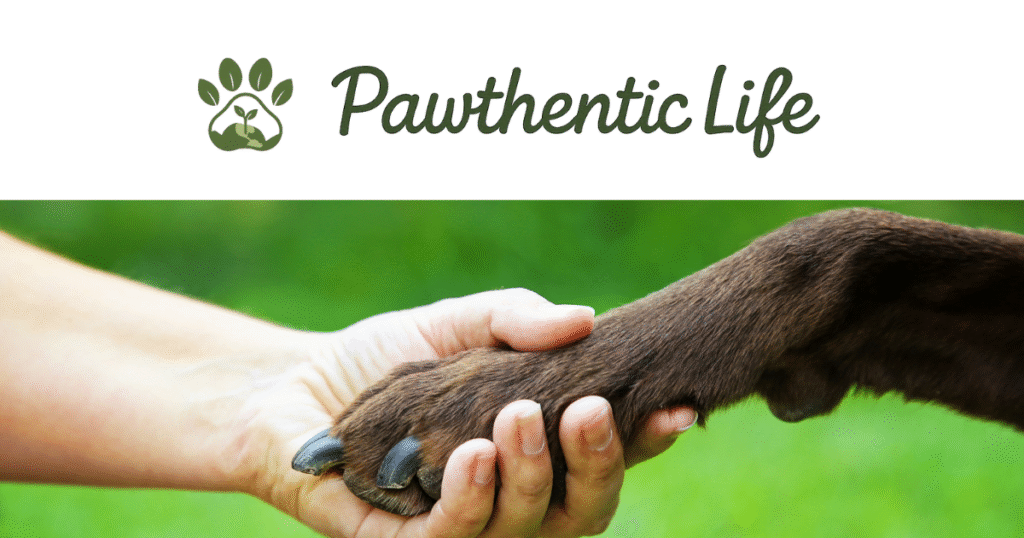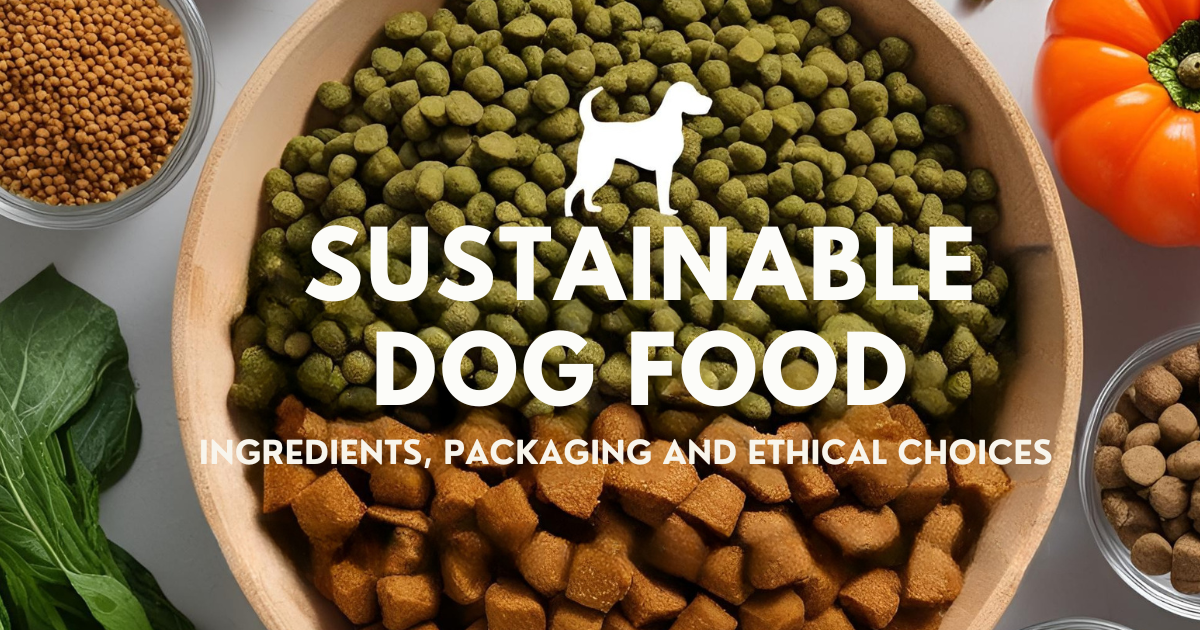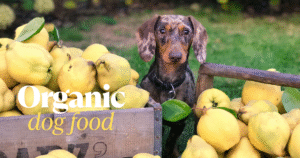Table of Contents
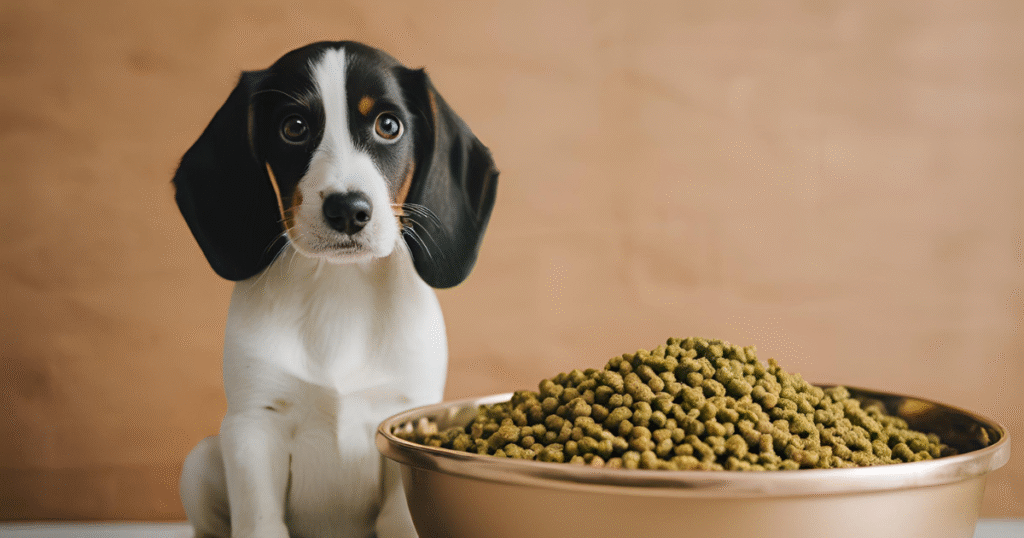
1. Our Furry Friends, Our Planet: Why Sustainable Dog Food Matters More Than Ever
Let’s be honest: our dogs are so much more than pets. They’re our co-pilots on road trips, our furry shadows around the house, our confidantes who never spill a secret, and integral members of our families. We shower them with love, adventures, and yes, the very best food we can find because their health and happiness mean the world to us.
But just as we’re becoming more aware of our own impact on the planet, it’s time we consider our dogs’ environmental “pawprints” too. This isn’t about feeling guilty; it’s about feeling empowered. It’s about making choices for our beloved companions that align with our values – choices that help ensure a healthier planet for everyone, including the future generations of humans and pups. Think of it as extending our eco-consciousness to the entire family, four-legged members included.
The reality is, the food we pour into their bowls has a surprisingly significant environmental footprint. Consider these points:
- Meat Consumption: Our dogs’ and cats’ diets account for a hefty chunk – estimated at 25-30% in the US – of the environmental impact stemming from meat consumption. Globally, producing pet food, especially dry kibble, uses vast tracts of land – an area roughly twice the size of the United Kingdom each year.
- Greenhouse Gas Emissions: The pet food industry releases tens of millions of tons of greenhouse gases (like CO2, methane, and nitrous oxide) annually. Some estimates place the industry’s emissions on par with entire countries like the Philippines or Mozambique. While scientists debate the exact numbers depending on how they measure things like by-products, the overall impact is undeniably substantial.
These figures aren’t meant to scare us, but to highlight why seeking sustainable dog food options is so important. It directly connects with the values many of us, especially Millennials and Gen Z, hold dear – caring for our planet while caring for our pets.
Interestingly, our deep love for our dogs and the trend of “humanizing” them – wanting them to eat as well as we do, often seeking out “human-grade” ingredients – can sometimes create a sustainability puzzle. We see “premium” and think prime cuts of meat, mirroring our own plates. However, traditional meat production is incredibly resource-intensive. From a purely sustainable standpoint, using nutritious “by-products” – the organ meats and other edible parts humans often don’t eat – is actually a brilliant way to reduce waste from the human food system. So, our well-intentioned desire to give them the “best” might inadvertently increase their environmental pawprint if we overlook the eco-logic of utilizing all parts of an animal resourcefully. It’s a reminder that “best” can mean healthy for the pup and healthy for the planet.
2. What Exactly Is Sustainable Dog Food? Demystifying the Buzzword
“Sustainable” – we see this word everywhere, but what does it truly mean when applied to dog food? At its core, sustainable dog food is about meeting our dogs’ nutritional needs today without messing things up for future generations. It’s about producing high-quality, nutritious food with the smallest possible environmental footprint, ensuring we manage resources like energy and water, and deal with waste responsibly. Think minimal impact, ecological balance, responsible ingredient sourcing, and ethical production practices from start to finish.
It’s crucial to understand that “sustainable” should be more than just a catchy marketing term slapped on a bag. True sustainability is a holistic approach, considering the entire life cycle of the dog food. This journey starts on the farm where ingredients are grown or raised, moves through manufacturing processes, includes the packaging the food comes in, considers the transportation needed to get it to us, and even extends to reducing food and packaging waste at home.
Why does defining this matter? Because understanding the full scope helps us cut through potential “greenwashing” – vague or misleading environmental claims. By knowing what genuine sustainability entails, we can ask the right questions and make choices that truly make a difference.
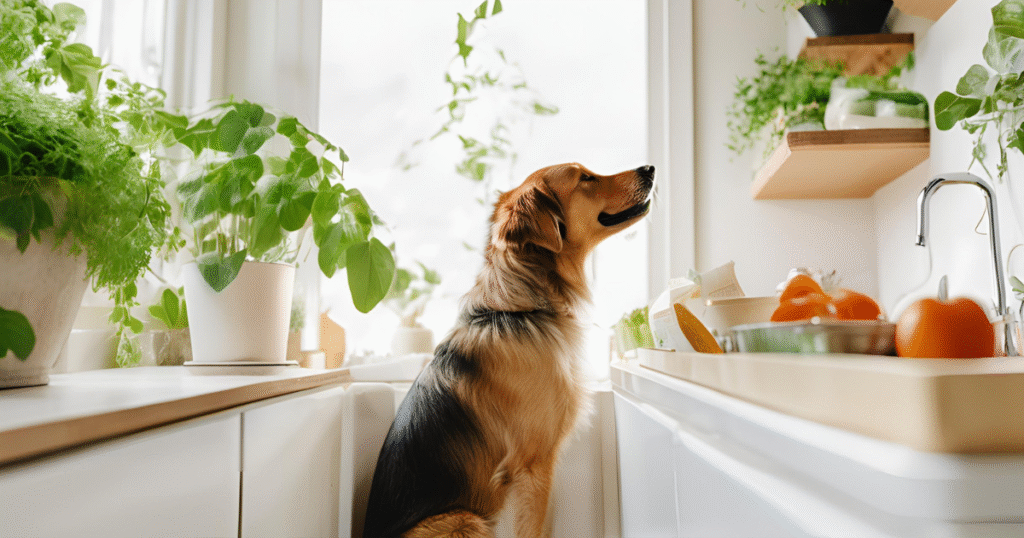
3. Decoding Sustainability: Key Factors to Look For When Choosing Dog Food
Okay, so we know why sustainable dog food matters and what it generally means. But navigating the pet food aisle (or website) can still feel like deciphering a secret code! Let’s break down the key areas where sustainability really counts. We need to look at what goes in the bag, the bag itself, and the company behind the bag.
3.1 Ingredient Sourcing: The Heart of the Matter
This is arguably the most critical piece of the puzzle. The ingredients used in dog food often account for the lion’s share – frequently over 50% – of its total carbon footprint. The choices made here have massive ripple effects on land use, water consumption, greenhouse gas emissions, and the health of our ecosystems.
Protein Power – The Big Debate: Protein is non-negotiable for our dogs’ health, but traditional meat production comes with a significant environmental price tag. Thankfully, the options are expanding:
- Responsibly Raised Meats: If meat is your preference, look for indicators of better farming practices. These often mean higher animal welfare standards and a lighter touch on the environment compared to intensive factory farming:
- Keywords & Certifications: Look for terms like cage-free, free-range, grass-fed, or pasture-raised. Certifications like Certified Humane, Global Animal Partnership (GAP), and Animal Welfare Approved by AGW offer third-party verification.
- Brand Example: Open Farm stands out here, building its brand on sourcing traceable, high-welfare meats with certifications like Certified Humane.
- Sustainable Seafood: For fish-based foods, seek out sustainably sourced options like wild-caught Alaskan salmon (used by brands like Canidae Sustain) or look for the Marine Stewardship Council (MSC) blue fish label. It’s worth noting, however, that some critics point out limitations in these certifications regarding broader ecosystem health or labor practices.
- Novel & Alternative Proteins: This is where things get really exciting! Innovative protein sources offer complete nutrition with potentially much lower environmental impacts:
- Insect Protein: Don’t squirm! Crickets, grubs (like mealworms), and Black Soldier Fly Larvae (BSFL) are nutritional powerhouses. Farming them requires dramatically less land, water, and feed, and generates far fewer greenhouse gases than traditional livestock. They’re often hypoallergenic and easy for dogs to digest. Plus, regulatory bodies like AAFCO (Association of American Feed Control Officials) are now officially approving specific insect ingredients for use in dog food, signaling their safety and viability.
- Brand Examples: Jiminy’s focuses heavily on cricket and grub protein. Yora and Green Petfood also utilize insect protein.
- Plant-Based Proteins (including Yeast): Vegan or vegetarian diets can be perfectly healthy for dogs, provided they are carefully formulated by experts to be nutritionally complete and meet AAFCO standards. Yeast protein is a particularly promising sustainable star – it’s a complete protein (containing all essential amino acids), has a very low carbon footprint compared to meat, and is often well-tolerated by dogs.
- Brand Examples: V-Dog is a pioneer in the vegan dog food space. Petaluma offers organic, plant-based kibble and is a certified B Corp. Canidae Sustain and Open Farm Kind Earth include plant-based options featuring yeast. Nature’s HUG also utilizes yeast protein.
- Lab-Grown (Cultivated) Meat: This is the newest frontier. Companies like Meatly have partnered with brands like The Pack to launch the first dog treats using meat cultivated from animal cells in a lab. The promise is real meat without the need for traditional animal agriculture. However, it’s still early days – currently expensive, available only in limited releases (treats, not full meals yet), and ongoing research is needed to fully understand its long-term environmental footprint and scalability compared to other sustainable options. Definitely one to keep an eye on for the future!
- Upcycled Ingredients: This is sustainability at its smartest! Upcycling means using the nutritious leftovers from human food production that might otherwise go to waste. Think spent grains from breweries, pulp from juice making, or those very same organ meats and by-products we mentioned earlier. It’s about resourcefulness, reducing food waste (which itself is a major environmental issue), and making the absolute most of the resources already used. This approach directly counters the potentially less sustainable push for only “human-grade” prime cuts.
- Brand Examples: Shameless Pets makes treats using upcycled ingredients. The Conscious Pet cleverly sources surplus food from restaurants. TerraPawz also focuses on upcycled treats. Many traditional brands also utilize meat by-products, which is fundamentally an upcycling practice that reduces waste.
- Invasive Species: Here’s a unique angle: some brands are tackling ecological problems by using overpopulated invasive species, like Asian Carp (specifically Silver Carp), in their recipes. This helps restore balance to affected ecosystems (like the Great Lakes and Mississippi River systems) while providing a nutritious, omega-3-rich protein source. It requires careful sourcing and testing to ensure safety from potential environmental contaminants like heavy metals.
- Brand Example: Chippin is known for using invasive Silver Carp alongside cricket protein.
Beyond Protein:
- Plants & Grains: Look for non-GMO ingredients. Organic fruits, vegetables, and grains are even better, as organic farming avoids synthetic pesticides and fertilizers, promoting healthier soil and water. Some brands also intentionally avoid common monoculture crops (like corn and soy, which can dominate landscapes) to support greater biodiversity.
- Local Sourcing: Choosing brands that source ingredients locally or manufacture regionally helps cut down on transportation emissions – the “food miles” associated with shipping ingredients across the country or globe. Look for claims like “Made in the USA” or specific regional sourcing information.
It’s tempting to think in simple terms – “beef bad, insects good.” But the reality of protein sustainability is more complex. While it’s generally true that beef and lamb carry the highest environmental burden, and insects or plants often have the lowest, the way an ingredient is produced can drastically change its impact. For example, beef raised using regenerative agriculture practices (which aim to improve soil health and sequester carbon) could potentially have a lower net impact than chicken raised in a conventional factory farm setting. And upcycled ingredients? They rewrite the equation by utilizing resources that have already been expended for human food production, drastically reducing the additional environmental cost. So, while the type of protein matters, we need to dig deeper. Look for how it was sourced – are there humane certifications? Is it organic? Is the company practicing regenerative agriculture? Is it an upcycled ingredient? These details often paint a clearer picture of sustainability than just the protein source itself.
3.2 Packaging: Beyond the Bag
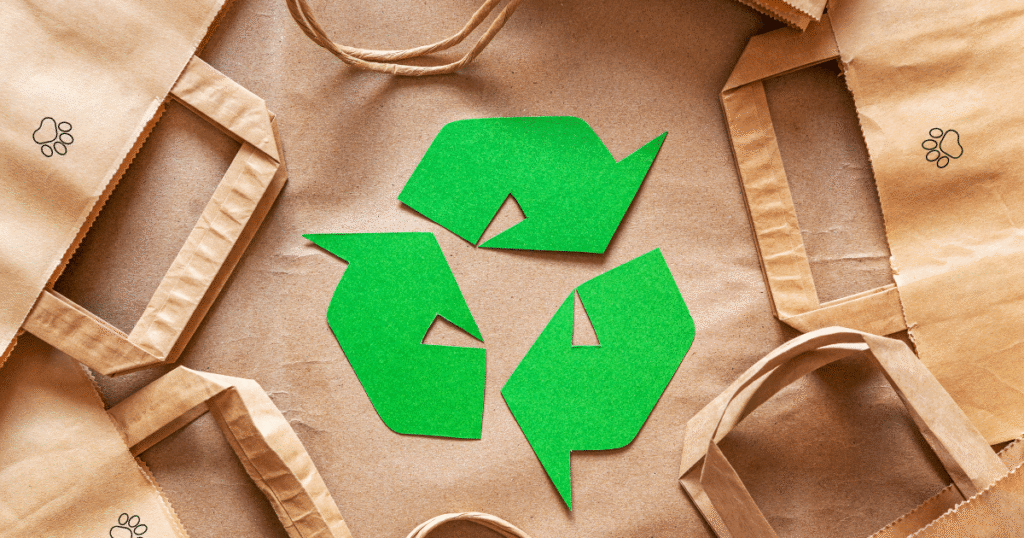
Let’s face it, those big bags of kibble create a lot of waste. The pet food industry in the US generates a staggering 300 million pounds of plastic packaging waste each year, and frustratingly, over 99% of it ends up in landfills, not recycled. That plastic takes hundreds of years to break down, polluting our land and oceans. But brands are starting to step up with better solutions:
- Recyclable Materials: Look for packaging made from materials your local facility can actually recycle. This might include bags made from a single type of plastic (mono-material), often labeled #4 LDPE or sometimes #7. Check your local recycling guidelines, as acceptance varies. Tetra Pak cartons, often used for wet foods, broths, and toppers, are widely recyclable in many areas.
- Recycled Content (PCR): This is a big one! Packaging made with Post-Consumer Recycled (PCR) content means less virgin plastic is being created. For instance, Canidae Sustain kibble bags boast 40% PCR content, made from recycled plastic bottles.
- Compostable Packaging: Some brands, especially for treats, are using materials designed to break down in a compost environment. Look for certifications indicating if it’s suitable for home composting or industrial facilities. Petaluma’s treat bags are a great example of home compostable packaging, and Beco offers compostable poop bags.
- Take-Back / Recycling Programs: Since many pet food bags are tricky to recycle curbside, some companies partner with TerraCycle. This allows you to collect the empty packaging and mail it back (usually with a free shipping label) to be properly recycled or repurposed. Brands like “I and love and you” and Open Farm participate in such programs. Check brand websites or ask your local independent pet store.
- Refill / Bulk Options: While still uncommon, the idea of bringing your own reusable container to fill up on kibble at the store is emerging (like TC Raw Eats’ local initiative in California). Buying the largest bag size feasible for you also generally reduces the amount of packaging waste per pound of food.
- Plastic Negative / Offset Programs: Some companies acknowledge their plastic use and take responsibility by funding the removal of plastic waste from the environment. Through partnerships with organizations like rePurpose Global, they pay to collect and recycle an equivalent (or even double) amount of plastic waste, often focusing on areas with high pollution rates. V-Dog uses this approach for its treat packaging.
While we push for more sustainable packaging, it’s important to remember its primary job: keeping the food safe, fresh, and nutritious. Sometimes, the most easily recyclable or compostable materials might not provide the same barrier against oxygen or moisture as traditional multi-layer plastics. This could potentially lead to shorter shelf lives or even food spoilage if not handled correctly. And food waste itself has a hefty environmental footprint, releasing methane in landfills and representing wasted resources. So, there can be a delicate balance. As consumers, alongside seeking brands using innovative, eco-friendly packaging, we can also do our part by buying appropriate bag sizes we know we’ll use before they expire and storing food properly to prevent waste. It’s all part of the sustainability picture.
3.3 Company Practices: Walking the Sustainable Talk
A truly sustainable brand lives its values beyond just the product itself. It’s about how the company operates and its overall ethical compass. Here’s what to look for:
- Transparency: Honesty and openness build trust, especially for younger consumers who value authenticity. Look for brands that readily share information:
- Ingredient Traceability: Can they tell you exactly where their ingredients come from? This level of detail adds accountability. Open Farm is a leader here, allowing customers to trace every single ingredient back to its source via their website.
- Environmental Reporting: Companies that publish annual sustainability or impact reports are demonstrating a commitment to measuring and improving their footprint.
- Manufacturing & Operations: How is the food actually made?
- Renewable Energy: Facilities powered by clean energy sources like solar or wind significantly cut down on operational greenhouse gas emissions. Petaluma bakes its food in a solar-powered facility, and Freshpet utilizes wind power.
- Carbon Neutrality/Offsetting: Forward-thinking companies measure their carbon footprint and take steps to reduce it or offset it by investing in projects that remove carbon from the atmosphere. Examples include Only Natural Pet (carbon neutral warehousing/shipping) and Petaluma (Climate Neutral Certified).
- Waste Reduction: Aiming for zero waste to landfill in manufacturing processes is another positive sign. Freshpet, for example, has goals to be landfill-free.
- Ethical Commitments: Sustainability also has social dimensions:
- Fair Labor Practices: Ensuring workers throughout the supply chain are treated ethically and paid fairly is crucial. Some brands, like Pezzy (treats), explicitly highlight fair wages for their fishery partners.
- Animal Welfare (Beyond the Food): Does the company conduct invasive taste tests on animals confined in labs? Many ethical brands explicitly state they do not. Does the company give back by supporting animal rescue shelters or welfare organizations?.
- B Corp Certification: This is a big one. Becoming a Certified B Corporation is a rigorous process that legally requires companies to consider the impact of their decisions on workers, customers, suppliers, the community, and the environment. It signifies a high level of commitment to social and environmental performance and transparency. Brands like Petaluma, Beco, and insect-supplier Ÿnsect hold this certification.
With so many claims and complex factors, how can we easily verify if a brand is truly walking the talk? This is where third-party certifications become invaluable. In a world where “greenwashing” can unfortunately happen, certifications like USDA Organic, Certified Humane, Marine Stewardship Council (MSC), Non-GMO Project Verified, and especially B Corp Certification act as trusted seals of approval. They provide standardized, audited proof that a company meets specific criteria, offering us, as consumers, a reliable shortcut to identifying brands genuinely committed to sustainable and ethical practices.
4. Our Top Picks: Sustainable Dog Food Brands Leading the Pack
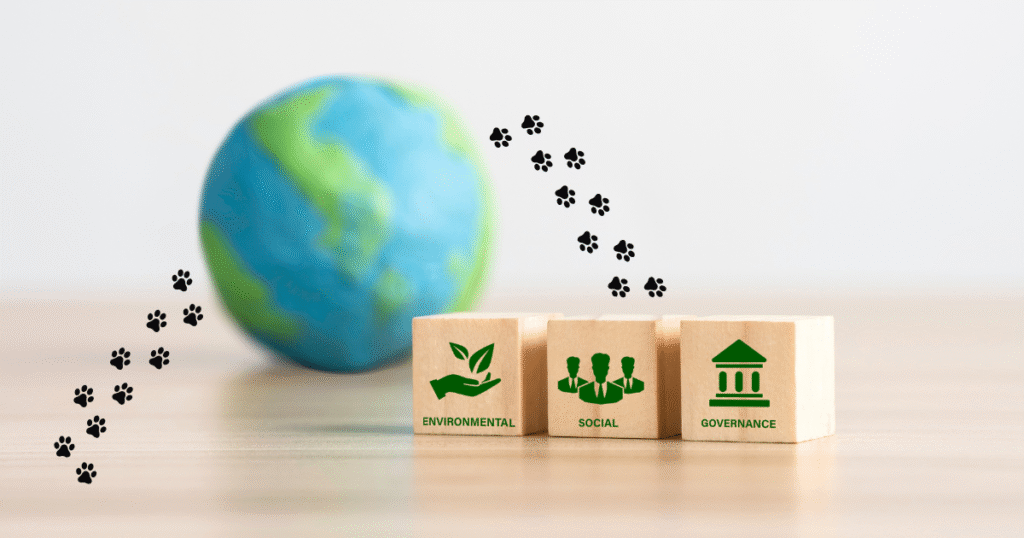
Choosing the single “best” sustainable dog food is tough because the “best” choice depends on your specific priorities – maybe you’re focused on plant-based options, or perhaps packaging recyclability is paramount, or you prioritize the highest animal welfare standards. It also depends, of course, on your dog’s individual nutritional needs and preferences!
That said, several brands are making impressive strides and deserve recognition for their commitment. Here are a few we admire, showcasing a range of approaches to sustainability:
Open Farm
- Focus/Mission: Radical transparency, ethical sourcing, and high animal welfare standards.
- Why We Love Them: Open Farm is obsessed with knowing exactly what goes into their food and sharing that information. They source meats with high animal welfare certifications like Certified Humane and ensure 100% traceability – you can literally enter a code from the bag on their website to see the origin of every ingredient. They offer a variety of proteins, including lower carbon options and a plant-based recipe. They also partner with TerraCycle for recycling their packaging, showing a commitment across the product lifecycle. Their transparency really resonates with the desire for authenticity.
- Considerations: Premium ingredients and sourcing often come with a higher price point.
Jiminy’s
- Focus/Mission: Sustainable nutrition powered by insect protein.
- Why We Love Them: Jiminy’s is a pioneer in using cricket and grub (mealworm) protein, highlighting the massive environmental savings in water and land use compared to traditional livestock. Their insect proteins are hypoallergenic, making them great for dogs with sensitivities, and highly digestible. They clearly communicate the positive impact switching can have (e.g., gallons of water saved). Plus, their food is made in the USA.
- Considerations: Insect protein is still a newer concept for some pet parents, but growing acceptance and AAFCO approvals are paving the way.
Petaluma
- Focus/Mission: Radically sustainable, plant-based nutrition with a focus on organic farming and measurable impact reduction.
- Why We Love Them: Petaluma offers a completely plant-based (vegan) kibble formulated by vets. They prioritize certified organic ingredients and avoid monoculture crops like corn and soy to support biodiversity. Their commitment runs deep: they bake their food in a solar-powered facility, use home compostable treat bags, are Climate Neutral Certified, donate 1% for the Planet, and are a Certified B Corporation with a top environmental score. They provide clear data on how their food reduces CO2 emissions, water use, and land use compared to traditional diets.
- Considerations: Currently offers plant-based recipes only.
Canidae Sustain
- Focus/Mission: Bringing sustainability to the mainstream with responsibly sourced ingredients, eco-friendly packaging, and support for regenerative agriculture.
- Why We Love Them: Canidae’s Sustain line offers recipes featuring responsibly sourced proteins like cage-free chicken (GAP certified) and wild-caught Alaskan salmon from sustainable fisheries. They also have a plant-based option utilizing nutrient-rich brewer’s yeast. Their packaging is a standout, with kibble bags made from 40% post-consumer recycled (PCR) material – one of the highest rates in the US – and wet food cartons (Tetra Paks) that are widely recyclable. They actively partner with US farmers practicing regenerative agriculture, aiming to improve soil health and sustainability from the ground up.
- Considerations: Offers a good balance, but may not hit the extreme ends of sustainability like fully vegan or insect-based for all products.
V-Dog
- Focus/Mission: Providing healthy, 100% vegan dog food with a strong ethical commitment to animal welfare and planetary health.
- Why We Love Them: V-Dog has been dedicated to plant-based dog nutrition since 2005. As a family-owned, all-vegan company, their mission is clear: proving dogs can thrive without animal products. They focus on nutritionally complete formulas and actively support animal rescue and welfare organizations. Recognizing the plastic challenge, they’ve achieved Plastic Negative certification for their treats through rePurpose Global, funding the removal of twice as much plastic from the environment as they use.
- Considerations: Offers vegan recipes only. Packaging for kibble is plastic (though offset efforts are in place).
Sustainable Dog Food Brand Snapshot
| Brand Name | Primary Protein Type(s) | Key Sustainability Feature | Packaging Highlight | Example Certification(s) |
|---|---|---|---|---|
| Open Farm | Ethical Meat, Sustainable Fish, Plant-Based | Traceability, Animal Welfare | TerraCycle Recycling Program | Certified Humane |
| Jiminy’s | Insect (Cricket, Grub) | Low Water/Land Use Protein | — | — |
| Petaluma | Plant-Based (Vegan) | Organic, Solar Power, B Corp | Home Compostable Treat Bags | USDA Organic, B Corp, Climate Neutral |
| Canidae Sustain | Ethical Meat, Sustainable Fish, Plant-Based (Yeast) | High PCR Packaging, Regen Ag | 40% PCR Kibble Bags, Tetra Paks | GAP (Chicken), MSC (Salmon) |
| V-Dog | Plant-Based (Vegan) | Vegan Mission, Animal Welfare | Plastic Negative (Treats) | — |
5. Making the Switch: Tips for Eco-Conscious Pet Parents
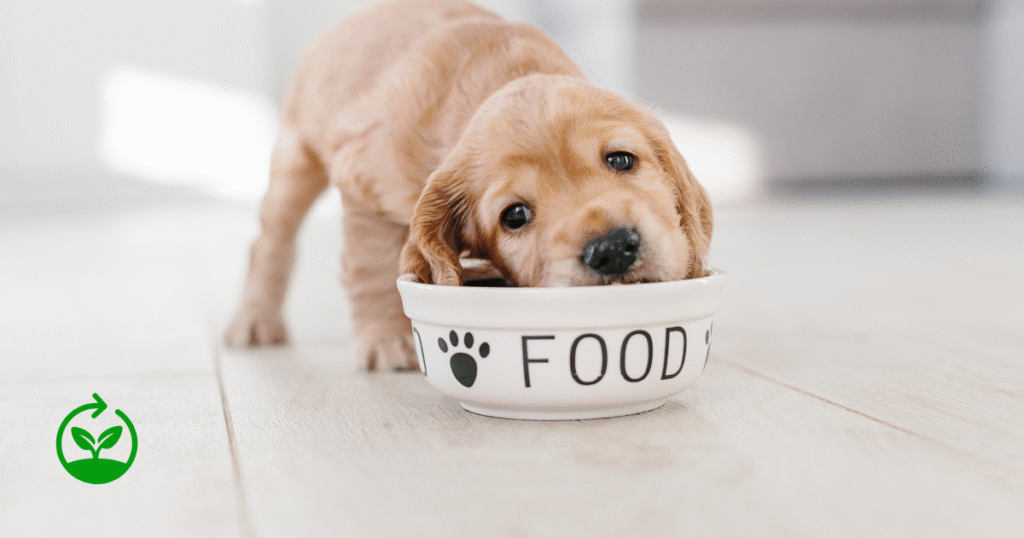
Ready to make a change? It doesn’t have to be complicated! Here are a few tips to help you and your pup transition smoothly:
- Start Small: Feeling overwhelmed by choice? Dip your toes in! Try switching to sustainable treats first – many brands offer these, often using insect protein or upcycled ingredients. Or consider adding a sustainable meal topper to their current food.
- Transition Gradually: This is crucial! Any sudden change in diet can upset your dog’s stomach. When introducing a new food, do it slowly over 7-10 days. Start by mixing about 25% new food with 75% old food for a few days, then move to 50/50, then 75% new/25% old, before finally switching completely to the new food.
- Read Labels & Websites: Become a sustainability detective! Look for the keywords, certifications (Organic, Certified Humane, B Corp, etc.), and sourcing information we’ve talked about. Don’t just rely on flashy claims on the front of the bag; dig into the ingredient list and check the company’s website for a dedicated sustainability page. Research shows many consumers rely on packaging labels for this info, so brands committed to transparency usually make it easy to find.
- Buy in Bulk (Mindfully): Opting for larger bags generally means less packaging waste per pound of food. Just make sure you can store it properly and use it all before it loses freshness to avoid food waste – remember, wasted food has its own environmental cost.
- Think Beyond the Bowl: Your pet’s sustainability journey doesn’t stop at food. Look for toys made from recycled or natural materials (like Beco’s recycled plastic or natural rubber toys), choose biodegradable or compostable poop bags, and generally try to be mindful of overall consumption.
- Engage & Advocate: Share what you learn! Chat with your veterinarian about sustainable nutrition options. Ask your local pet store about brands with recycling programs or sustainable practices. Talk to fellow pet parents. Consumer demand is a powerful force for change in the industry.
6. Frequently Asked Questions (FAQ)
- Q1: Is sustainable dog food nutritionally complete and safe?
- Answer: Yes, absolutely! Reputable sustainable brands prioritize nutrition just as much as sustainability. They work closely with veterinary nutritionists to formulate recipes that meet or exceed the standards set by AAFCO (Association of American Feed Control Officials) for “complete and balanced” nutrition for your dog’s specific life stage (puppy, adult, senior). Always look for the AAFCO nutritional adequacy statement on the packaging. Good brands also conduct safety testing on their products.
- Q2: Is sustainable dog food always more expensive?
- Answer: It often comes with a higher price tag, and that’s usually a reflection of the real costs involved. Sourcing high-quality, ethically produced ingredients (like organic produce or humanely raised meats), investing in sustainable farming practices, using eco-friendly packaging materials, obtaining third-party certifications, and ensuring fair labor practices all cost more than conventional methods. Think of it as an investment – potentially in your pet’s long-term health (which could mean fewer vet bills) and definitely in supporting a food system that aligns with your values. While some brands might offer better value, surveys show many pet parents, especially Millennials and Gen Z, are willing to pay a bit more for sustainability.
- Q3: What’s the most sustainable protein source for dogs?
- Answer: As we discussed, it’s nuanced! But generally speaking, plant-based proteins (like sustainably sourced soy, pea, or yeast) and insect proteins tend to have the lowest environmental footprints regarding land use, water consumption, and greenhouse gas emissions. Upcycled ingredients are also incredibly sustainable because they prevent food waste. Among traditional meats, poultry and fish usually have lower impacts than red meats like beef or lamb. However, the production method (e.g., regenerative farming, humane certifications) is just as important, if not more so, than the protein type itself. Look for transparency and verified claims!
- Q4: Can my dog really thrive on a vegan or vegetarian diet?
- Answer: Yes, dogs can! Unlike cats, who are obligate carnivores needing meat, dogs are physiologically omnivores and can do very well on properly formulated plant-based diets. The absolute key is ensuring the diet is “complete and balanced,” providing all the essential nutrients, including amino acids (which might require careful blending of plant proteins or using sources like nutritional yeast), vitamins, and minerals, and that it meets AAFCO standards. If you’re considering making the switch, it’s always a good idea to discuss it with your veterinarian first.
- Q5: How can I recycle my dog food bags? They don’t go in my curbside bin!
- Answer: You’re right, this is a common frustration! Most standard kibble bags are made of multiple layers of different materials fused together, making them difficult for typical municipal recycling facilities to process. Your best bet is to check if the specific brand partners with TerraCycle – they often provide free shipping labels for you to mail back the empty bags. Some independent pet stores also have collection bins for specific brands or bag types. Also, keep an eye out for brands shifting to simpler, mono-material bags (like #4 or #7 plastic) which might be accepted locally – always check with your local recycling program. Choosing wet food or toppers in recyclable Tetra Paks or treats in certified compostable bags are other ways to sidestep the kibble bag issue.
7. Conclusion: Small Changes, Big Impact
Choosing sustainable dog food is more than just a trend; it’s a meaningful way we can extend our care for the planet to our furry family members. It involves looking deeper than the front of the bag – considering where ingredients come from, how they’re produced, the packaging they arrive in, and the overall ethics of the company behind the brand.
It might seem like one bag of dog food won’t change the world, but collectively, our choices have power. Every time we opt for a brand committed to responsible sourcing, humane practices, innovative lower-impact proteins, eco-friendly packaging, and transparent operations, we send a message. We help build demand for a better way of feeding our pets, pushing the entire industry towards a more sustainable future.
So, explore the brands we’ve mentioned, use the tips here to do your own research, and find the sustainable option that feels right for you, your values, and most importantly, your wonderful dog. Let’s nourish them with love, joy, and food that’s good for them and gentle on the Earth we all share.
